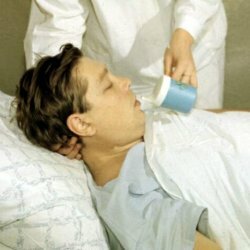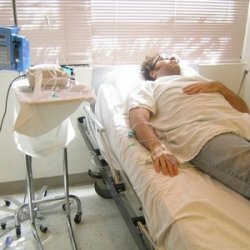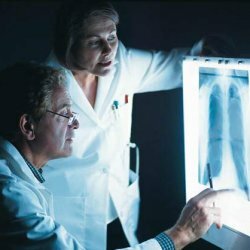Poisoning caused by intoxication of the respiratory system
 Negative effects on the lungs are usually the result of the interaction of toxic gases and vapors. There are many chemical compounds that form substances hazardous to human health. As a consequence, irritation of the lung tissue, the appearance of shortness of breath, coughing and burning sensation in the chest. Asphyxiant gases resulting from combustion provoke poisoning, intensifying the effect at a strong concentration in enclosed spaces, as they absorb the life-giving oxygen from the environment.
Negative effects on the lungs are usually the result of the interaction of toxic gases and vapors. There are many chemical compounds that form substances hazardous to human health. As a consequence, irritation of the lung tissue, the appearance of shortness of breath, coughing and burning sensation in the chest. Asphyxiant gases resulting from combustion provoke poisoning, intensifying the effect at a strong concentration in enclosed spaces, as they absorb the life-giving oxygen from the environment.
The defeat of the respiratory system depends on the concentration of the reagent and the time of exposure to the body.
When poisoning must take into account the fact that many of the toxic gases do not have a characteristic smell. As a general rule, with the first signs of poisoning in a confined space, it is necessary to ensure the patency of the airways.
A huge amount of intoxication is associated with the penetration of harmful gases, vapors and aerosols into the human body mainly through the lungs. This intake of poisons poses the greatest danger, since poisonous compounds pass through the pulmonary alveoli directly into the circulatory system and spread throughout the body. The mechanism of the negative effect of gases is largely associated with penetration into the deep lung tissue, into the lymph and, entering the blood, causes poisoning.
Distinguish between chronic and acute poisoning
Acute intoxication is the result of accidents and natural disasters when people are in an isolated gassed room.
The acute forms include: toxic tracheitis, toxic bronchitis, toxic pulmonary edema, toxic bronchitis, toxic pneumonia.
Strong lung lesions are characterized by complaints of problematic breathing through the nose, sore throat, cough, hoarseness;In some cases there is a difficulty in the respiratory function up to asphyxia.
The entry of dangerous chemical compounds into the body in sufficiently large amounts occurs at elevated concentrations in the air. It happens that a strong poisoning can occur when exposure to gasoline vapors, preparations containing sulfur, and have a lethal outcome from paralysis of the respiratory tract, if a person is not provided with clean air. Nitrogenous compounds in some situations provoke the development of toxic coma, paralysis, and blood pressure jumps.
In addition, pulmonary tissue lesions depend on the size of the respirable particles and the solubility of the gas compounds. Most of the gases containing chlorine, ammonia, hydrogen cause instant irritation of the mucous membrane and with urgent ventilation of the lungs do not cause significant damage.
The chronic form of intoxication develops as a result of prolonged exposure to small concentrations of dangerous irritants, single intoxication or repeated acute poisoning. Lesions of the lung tissue in the chronic course of the disease are often found and find themselves in the form of chronic diseases right up to the genyantritis and displacement of the septum of the nose. Such processes are periodically accompanied by nasal bleeding, dryness in the throat, the appearance of a cough.
Under the influence of harmful gases and vapors, chronic bronchitis can develop in contacting patients. In such cases, changes in the work of the upper respiration are observed. At laboratory researches deformations and scars in bronchial tubes, development of emphysema of lungs are revealed. Inhaled permanent effects of certain chemical reagents can cause lung cancer.
Symptoms of respiratory tract infection
Essential symptoms of toxic poisoning are: the appearance of dyspnea, migraine, dizziness, nausea, sometimes vomiting, in some cases, loss of consciousness.
In addition to specific symptoms, inhalation of toxic substances usually develops hypoxia, and it is its severity often determines the prognosis.
Symptoms of poisoning with gases usually increase gradually, as the concentration of reagents in the human blood increases. On the background of intoxication, cardiac dysfunction appears.
First aid for various respiratory intoxications
When toxic gas enters the upper respiratory tract, not only lung intoxication occurs, but also the penetration of hazardous substances into all important human organs. Therefore, as soon as possible, it is necessary to evacuate the victim from the affected area. In the warm season it is best to take a person to fresh air. With a weak rare breath and with complete stopping of breathing, artificial respiration is necessary. In the presence of a first aid kit, it is recommended to bring ammonia to the victim's nose. You can give any sorbent. Medical sorbents are used in poisoning to bind chemicals that have entered the human body and cause negative consequences.
In case of stopping the work of the heart muscle, you need to do a direct heart massage. Then you need to provide a person with warm clothes and a blanket. To the legs is best to attach a heating pad. It is also necessary to provide the patient with an abundant drink. In case of severe poisoning, it is strongly recommended to call an ambulance and place the victim in a medical institution. When poisoning with carbon monoxide and poisonous gases, oxygen must be supplied until the respiratory function is restored. When poisoning with harmful gases and vapors, in no case should it be possible to administer powerful sedatives. The patient is recommended to adhere to bed rest for at least a day before the final recovery.
Prevention of Poisoning Associated with Damage to the Respiratory System
One of the most important preventive measures is observance of caution when interacting with chemical compounds, including with toxic gases. Use personal protective equipment( work clothes, masks, respirators, in some cases gas masks).
Prevention of acute intoxication with gases, vapors and aerosols of damaging effects includes a set of measures to ensure a safe workplace and prevent accidents, the use of individual and collective protective equipment. This is a measure of primary prevention. There are measures of secondary prevention by definition of medical individual indicators. It is necessary to strictly comply with the medical regulations for the admission of a certain category of workers to dangerous drugs.
Here the determining factors are the general health state, the reaction to allergens, the presence of chronic respiratory diseases and the central nervous system with functional and organic impairments of the respiratory and nervous systems.
Diagnosis of intoxication of the respiratory organs specializes in conducting anamnesis, determining the clinical picture, the data of laboratory tests.
Prevention of intoxication of the respiratory system is based on the implementation of special standards and requirements in accordance with GOST, carrying out a survey and examination of employees, observance of medical regulations for access to work with poisons and harmful chemical preparations, medical examinations at the workplace. Measures in this area include the possibility of rehabilitation of people who have been exposed to intoxication in productive activities.



